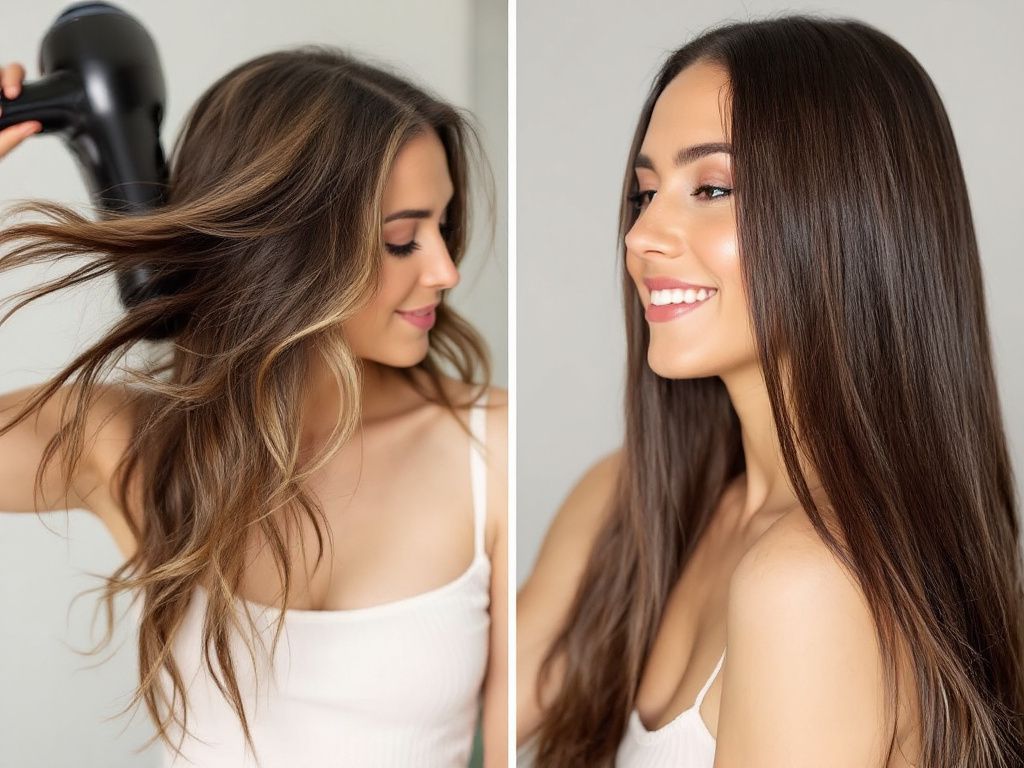
Let’s face it, we’re always hustling between work, family, hobbies, and maybe, just maybe, a bit of self-care. So when it comes to something as mundane as drying hair, it’s tempting to take the quickest route possible, right? But hold up a second—have you ever weighed the pros and cons of air drying versus blow drying your hair? Trust me, it might be worth a look.
From healthier hair ambitions to precious morning minutes saved, each method has its allure. Let’s break it down and dig into whether air drying or blow drying will best fit your lifestyle, helping you rock your locks just the way you want.
What’s Going On With Your Hair?
First, let’s chat about what exactly happens when you dry your hair, shall we? Wet hair is at its most vulnerable state. The water breaks down certain bonds in your hair, making it more elastic and, yeah, prone to damage. How you dry it can mean the difference between gloriously healthy hair and… well, not so great strands.
Now, whether you’re team “natural vibe” or your mantra is “blown to perfect coils,” understanding the nature of hair drying can equip you with the know-how to make informed—rather stylish—decisions.
The Low Down on Air Drying
Air drying, by the very term, sounds refreshingly simple. Imagine emerging from the shower and letting nature do the drying for you. There’s a sort of zen simplicity in it. But is it as advantageous as it seems?
Pros of Air Drying
- Less Heat Damage: One of the biggest victories for air drying is skipping out on the heat. High temperatures from styling tools can do a real number on hair cuticles. Air drying? Whew, none of that’s involved.
- Effortless Shine: Seriously, give this a try. By dodging the blow dryer, your hair’s natural oils stick around a bit longer, often giving strands a more vibrant shine.
- Saves on Energy & Noise Pollution: Not to sound too green-friendly, but you’ll lessen your energy use with this one. And no annoying hair dryer noise disrupting your favorite podcast listening.
- Enhanced Natural Texture: Curl ambassadors, this is for you! Air drying can help enhance your natural wave or curls without numbing them into submission.
Cons of Air Drying

- Time-Consuming: If you’re running a packed schedule, air drying might feel like a slow boat to China. It can take hours, depending on hair thickness and climate conditions.
- Lacks Polish & Control: Sometimes, air drying leaves the hair a little frizzy or wilder than you might prefer. Got a crucial meeting? You might end up disappointed if things don’t settle down as planned.
- Humidity Hang-Ups: Living in a humid area can mean air drying causes your hair to go from sleek to puff-ball status in no time flat.
—
The Blow Drying Rundown
Now, if you love some pampering acceleration on your hair, blow drying might be your best stylist pal. Who doesn’t enjoy the feeling of salon-level allure right from their cozy bathroom setup? But it’s not all smooth sailing.
Pros of Blow Drying
- Goodbye, Wet Hair: Blow drying speeds up the entire process. It’s perfect for days you need to jet out of the house quickly.
- Control & Style Mastery: If polished looks are your thing, blow drying lets you command your mane in multiple ways—a peak control & finish doer.
- Elevates Volume and Texture: Got limp locks? Blow drying can be your ticket to bouncy, volumized hair that’ll get all the double takers!
- All-Weather Versatility: Rain outside? No problem! A quick blow-dry ensures your hairstyle stays intact against external elements.
Cons of Blow Drying
- Heat Overload: High heat exposure can make hair brittle or cause split ends. Unless you’re using a heat protectant, you may need a hair rehab in the long run.
- Hits Your Energy Bill: Let’s not pretend, using an appliance regularly can affect your energy consumption and costs over time.
- Requires Tools and Skills: Mastering the blow-dry technique can take a bit. You’ll need brushes, heat protectants, maybe some spritzes—it’s an invested affair.
- Environmentally Strenuous: Regular blow drying can potentially lead to sustainability concerns. Something to be mindful of for sure.
—-

Making the Choice: Air Drying in the Spotlight
Whether plunging into air drying or grabbing a blow dryer, understanding your hair’s needs is key. Air drying might become your go-to if:
- You Cherish “Less is More”: If minimal product & effort are your jam, air drying yields to that fresh ideology.
- Natural Texture Enthusiast: Looking to nourish your natural curls? Air drying can be a step towards visually framing your wavy reality.
- Conscious of Heat Dilemmas: If preserving hair health tops your list, avoiding heat tools is non-negotiable. Air drying is your happy companion here.
- Time Well Spent: For those testaments giving lists priority over hair goals, you’ll thrive with the patience factor of air drying.
Steps to Effective Air Drying
Here’s the lowdown that’ll make air drying delightful:
- Pre-dry Little Bits: After showering, gently pat your hair with a microfiber towel. Resist the urge to rub or tousle—frizz alert!
- Detangle Appropriately: Use your fingers or a wide-toothed comb to ease through any tangles. Unfortunately, ignoring knots when hair is wet leads to breakage.
- Taming Adds: Say hello to a nice leave-in serum or curly custard which helps shape without leaving residue.
- Avoid Over-combing: Unless the frizz wants company, once you’re done, that’s it.
—

Blow Drying: A Go-to Routine?
On the flip side, blow drying’s rapidness might look compelling if:
- Quick, Praiseworthy Effects Needed: If your outings demand formality and pronto showcases for your hair, this lands you model-worthy ease.
- Meticulous Masters Approved: Hair looks requiring an artist’s touch? The compliance of a blow dry has your name on it.
- Weather Warriors Welcome: Flaunting styles that don’t bow in bad weather.
Steps to Perfect Blow Drying
Inform your locks with flawless light and catch waves of admiring gazes:
- Pre-conditioning Pointers: After shampooing, apply a heat protectant throughout your strands for a healthy ego.
- Section for Heat Mastery: Split hair into operable sections to balance your technique—a load becomes lighter.
- Guide with a Brush: Rapid blending between vented round brushes smoothens each level of your form.
- Settle Seams: The healthy sheen involves finishing with a flash of cool air—astonish in waves.
—-
Conclusion: Choose Your Adventure
So, where does this leave us? Are you cozy in the calm of air-drying weekends basking just with an audiobook, or do you jive well when blow drying caters to high-caliber meetings with curated flair?
With hair care, a one-size-fits-all rulebook doesn’t exist. Your locks, schedule, and lifestyle shape the drying story that works for you. Spending these fleeting minutes in ways that mutually benefit hair craft and kingdom ambitions gets our head tilting in positive directions.
However you choose, embrace it. Let it reflect you and maybe, encourage a confident hair flip at that. Just a thought—after all, your crown should feel comfy and tailored as you like it!
Frequently Asked Questions
How often should I wash my face mask to prevent maskne?
To prevent maskne, it is crucial to wash your face mask regularly. For fabric masks, wash them after every use, similar to how you would wash your underwear[2][3][4]. Disposable masks should be tossed after each use to prevent the buildup of bacteria and other contaminants[3][5>.
What type of skincare products are best for preventing maskne?
For preventing maskne, use skincare products that are oil-free or noncomedogenic. These products, such as gentle cleansers, moisturizers, and sunscreens, help prevent clogged pores and reduce the risk of acne. Look for products containing salicylic acid or benzoyl peroxide for their acne-fighting properties[1][3][4>.
How can I reduce friction and irritation caused by wearing a face mask?
To reduce friction and irritation, choose a mask that fits well and is made from breathable fabrics like cotton or bamboo. Loosen the mask straps, use pads under the straps, or consider a headband-style mask to minimize friction. Taking brief breaks to remove the mask and allow your skin to breathe can also help[2][3][5>.
What are some additional tips to prevent maskne while wearing a face mask?
In addition to regular mask washing and using the right skincare products, avoid touching your face, skip makeup or use noncomedogenic makeup, and moisturize your skin to keep it hydrated. Also, limit the use of active ingredients like retinol or benzoyl peroxide during the day when wearing a mask, and consider using a topical antimicrobial cream to prevent bacterial buildup[1][3][4>.
References


Leave a Reply